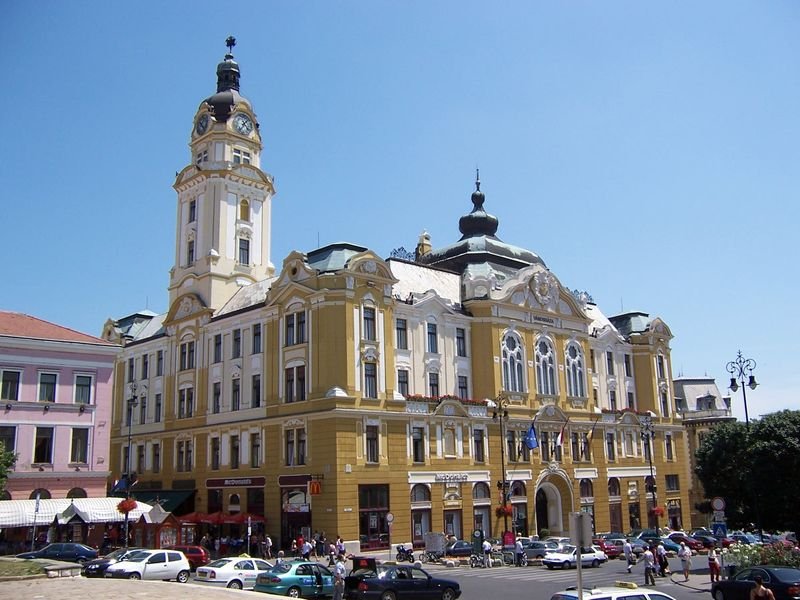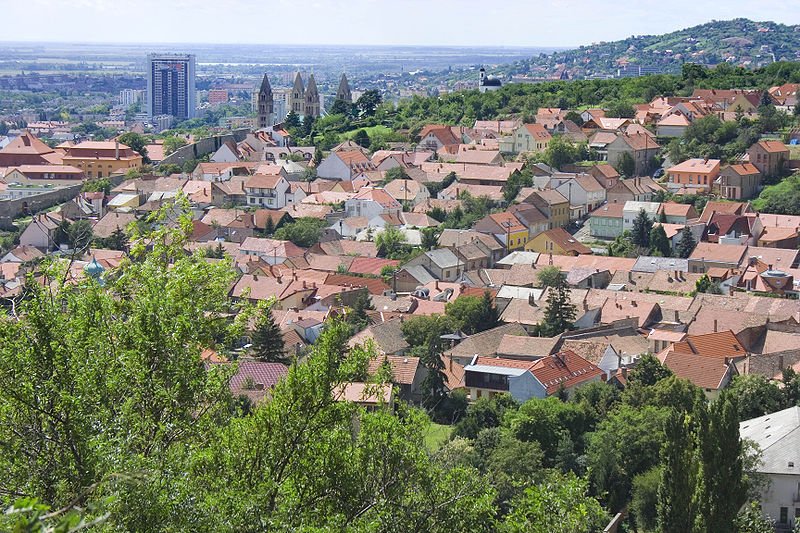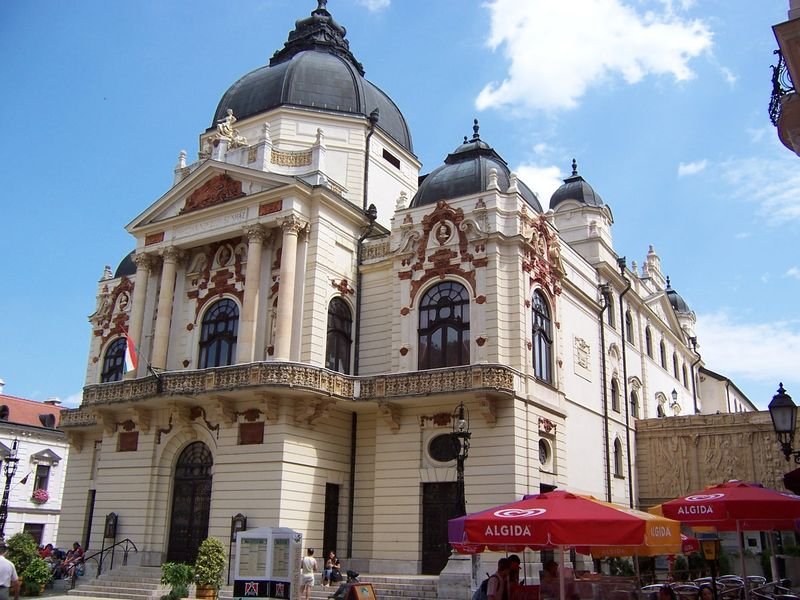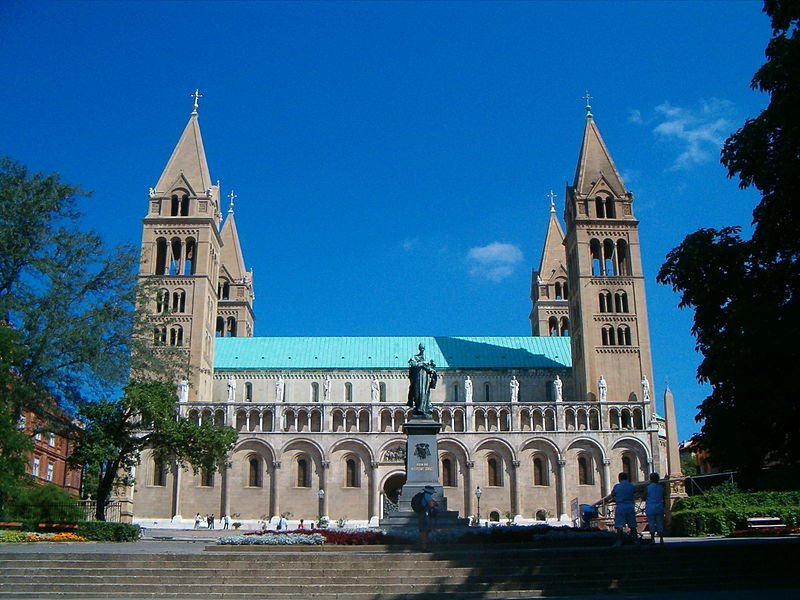 Pécs, Hungary
Pécs, HungarySource: https://commons.wikimedia.org/wiki/File:P%C3%A9csi_hegyoldal_P.JPG
Author: Pilgab, stitched by Marku1988

Pécs is a city in Baranya county in southwestern Hungary. It covers 162.61 sq km (62.8 sq mi) and has a population of 158,000 (2011 estimate). It is the fifth largest city in the country.
Pécs is located on the slopes of the Mecsek mountains, in the Carpathian Basin, near the border with Croatia. It serves as the economic and administrative hub of the Baranya county. The city is often called Hungary's Mediterranean, as it receives more sunshine than any other major city in the country.
 Pécs City Hall
Pécs City HallSource: https://commons.wikimedia.org/wiki/File:Hungary_Pecs_2005_June_038.jpg
Author: Csörföly D

Pécs experiences a humid continental climate. July is the warmest month in the city, with average high temperature of 26.3°C (79.3°F). Coldest month is January, when the average low temperature drops to -4°C (24.8°F). June receives the most rain, at 84 mm (3.31 in).
Pécs was founded by the Romans in the 3rd century AD, and was originally known as Sopianae. Before the arrival of the Romans, the area was already inhabited by Celtic and Pannoni tribes. In 871, it was referred to as Quinque Basilicae (five basilicas), in the earliest documented mention of the city, because the cathedral was built with building material taken from five chapels.
The Carpathian Basin was conquered by Hungarians in the 9th century. Pécs became an important religious center, and was called Quinque Ecclesiae. Pécs's original cathedral burned down in the 11th century, and its present cathedral was constructed over the original one after that.
 Tettye in Pecs, Hungary
Tettye in Pecs, HungarySource: https://commons.wikimedia.org/wiki/File:Pecs_Tettye_02.jpg
Author: Takkk

Pécs was first occupied by the Ottomans in 1526 and ruled it until 1664, when it was pillaged and destroyed by Croat nobleman Nicholas Zrínyi. Remnants of sites that survive the attack include a number of mosques, minarets and ancient Christian tombs.
By the 17th century, Pécs began to develop once more. By then its population was dominated by an influx of German immigrants who outnumbered the Hungarians. By the 18th century, Pécs was becoming a center for industry, trade and viticulture. Except for the occasional attack by a neighboring power, it was largely ruled by the Habsburg empire.
 Pécs National Theater
Pécs National TheaterSource: https://commons.wikimedia.org/wiki/File:Hungary_Pecs_2005_June_068.jpg
Author: Csörföly D

Unlike other cities in Europe, Pécs managed the avoid the worst destructions of the Second World War. It began to grow again after the war, extending its borders to include nearby towns. Today Pécs is a modern, developed city. It was the European Capital of Culture in 2010, sharing the title with Essen and Istanbul. The early Christian necropolis of Pécs was also recognized as a World Heritage Site in 2000.
Visiting Pécs
You can reach Pécs by taking a train from Budapest. The journey takes two hours forty minutes on the express service. There are also trains from Osijek in Croatia, Sarajevo in Bosnia and Herzegovina, and Vienna, Austria. Pécs Cathedral
Pécs CathedralSource: https://commons.wikimedia.org/wiki/File:Hungary_pecs_-_szekesegyhaz1.jpg
Author: Váradi Zsolt

Places of Interest in Pécs
- Apáca Street
Street with one of the earliest Christian burial in Europe, dating to around 390 AD. - Archaeological Museum
Museum showcasing the different periods of the city's history, with particular emphasis on the Roman period, when the city was called Sopianae. - Bishops' Palace (Püspöki palota)
Residence of the bishop built in the 19th century in the Neo-Renaissance style. - Csontváry Museum (Csontváry Múzeum)
Museum showcasing the work of Tivadar Csontváry Kosztka (1853-1919). It has been housed in this Neo-Renaissance building since 1973. - Early Christian Mausoleum
Necropolis today a World Heritage Site, dating to around 275 AD, located below an excavated chapel. - Gazi Kasim Pasha Mosque (Gazi Kasim Pasha Dzámi)
This was the largest mosque in Hungary. It was built in 1579 by the Ottomans over the site of a Gothic Christian church. In the 17th century, it was converted back to a church, the City Parish Church (Belvárosi templom). - Jakovali Hassan Mosque (Jakovali Hassan Dzámi)
16th century Ottoman mosque that was converted into a Christian church in 1714. It however cannot mask the original mosque appearance, with it high minaret. Today it is converted into a museum recounting Ottoman rule in Pécs. - Király Street (Király utca)
Pedestrianized street with several superbly preserved historic buildings. - Pécs Synagogue (Zsinagóga)
Place of worship for the city's Jewish community built in the Neo-Renaissance style in the 1860s, it can accommodate 5,000 worshippers. The Jews in Hungary suffered greatly during the shortlived rule of the Hungarian Arrow Cross Party, when some 80,000 of them were sent to the Auschwitz concentration camp. Less than 500 Jews in Pécs survived the war. - Széchenyi Square
Medieval heart of Pécs, with many historic buildings lining it or within its immediate vicinity, among them the Town Hall, Zsolnay Fountain, János Hunyadi Monument, Zsolnay Museum, Gazi Kasim Mosque, Király Street, National Theater, Holy Trinity Monument and Archaeological Museum. - St Peter's Cathedral (Szent Péter Székesegyház)
Located in Dóm tér, or cathedral square, in the middle of Pécs, the present cathedral dates to 1891. it replaces the original Neo-Romanesque building from 1009 and the Baroque version built in 1064. - Zsolnay Museum (Zsolnay Múzeum)
Occupying the oldest house in Pécs, this museum displays some of the best ceramics produced by the Zsolnay Ceramic Factory.
 Latest updates on Penang Travel Tips
Latest updates on Penang Travel Tips

Copyright © 2003-2025 Timothy Tye. All Rights Reserved.

 Go Back
Go Back